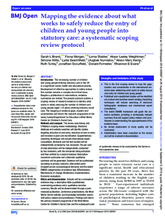Displaying 741 - 750 of 2214
This editorial summarises a range of research in this special issue covering parenting styles, transitions out of care, child sexual exploitation, and the needs of LGBTQ and separated teenagers.
This secondary analysis of data describing 3,035 parents, drawn from the National Survey of Child and Adolescent Well-Being II, identified factors fostering the collaborative alliance of parents and caseworkers within the child welfare system.
The present protocol outlines a scoping review of research evidence to identify what works in safely reducing the number of children and young people (aged ≤18 years) entering statutory social care.
Using evidence from the evaluation of specialist foster care provision and a child sexual exploitation (CSE) training course for foster carers, this paper [from the Child & Family Social Work special issue on teenagers in foster care] considers how training might be used to widen the pool of potential foster carers for children affected by CSE and identifies qualities displayed by effective carers.
The aim of this article [from the Child & Family Social Work special issue on teenagers in foster care] is to account for and discuss support to young care leavers within the comparable welfare regimes of Norway and Sweden and to explore key differences between these 2 countries.
This special issue of the Child & Family Social Work journal focuses on teenagers in foster care. Articles and papers in this issue include:
In this article [from the Child & Family Social Work special issue on teenagers in foster care], the author reviews a range of theoretical and practical issues that are relevant to the foster care of teenagers.
This paper [from the Child & Family Social Work special issue on teenagers in foster care] reports findings from the first UK study into the experiences of unaccompanied asylum‐seeking young people in the UK, describing issues arising from initial assessment and preparation for fostering and the ways in which young people and foster carers adjusted to their lives together.
Based on field studies and in-depth interviews across rural and urban China, this book presents a socio-legal analysis of non-state organised care for some of China's most vulnerable children.
This open access article reports on a qualitative study, which sought to retrospectively understand the contribution family group conferencing (FGC) makes to longer‐term outcomes for children at risk of entering State care and their families.

